
The Joseph Reynolds House is a historic house at 956 Hope Street in Bristol, Rhode Island, United States, built c. 1698–1700. The three-story wood-frame house is one of the oldest buildings in Bristol and the oldest known three-story building in Rhode Island. It exhibits distinctive, well-preserved First Period features not found in other houses, despite an extensive history of adaptive alterations. It is further significant for its use by the Marquis de Lafayette as headquarters during the American Revolutionary War. It was designated a National Historic Landmark in 1983.
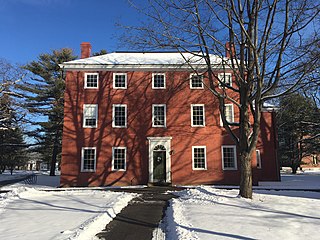
Massachusetts Hall is the oldest building on the campus of Bowdoin College, in Brunswick, Maine. It was built 1798–1802, and has seen a number of uses during the school's long history. The building was listed on the National Register of Historic Places in 1971.
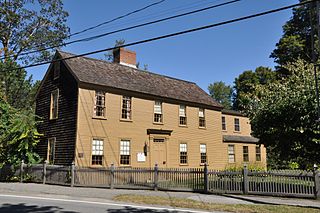
The Adams–Clarke House is a historic late First Period house in Georgetown, Massachusetts. Built about 1725, it retains a number of features transitional between the First and Second periods of colonial architecture. It was listed on the National Register of Historic Places in 1990.

The Peter Woodbury House is a historic First Period house in Beverly, Massachusetts. It is a 2+1⁄2-story wood-frame structure, five bays wide, with a side-gable roof, large central chimney, and clapboard siding. Like most surviving First Period houses, this one was built in stages. The earliest part, dating to c. 1696, was the right front section and chimney. The left side was built in the 18th century, as was the rear leanto, which was later raised to a full second story.

The Brown House is a historic First Period house in Hamilton, Massachusetts. Built in the 1660s or 1670s, it is one of the oldest surviving houses in Essex County. It was listed on the National Register of Historic Places in 1990.

The James Burnham House is a historic First Period house in Ipswich, Massachusetts. Burnham, who was apparently a wealthy man, lived in three different houses in the area from the 1670s to 1703. This is house is believed to be one that he purchased from Samuel Poad in 1677, based on what is known of the various properties and related transactions. The main body of the house exhibits no exposed evidence of its 17th century origins, but analysis of its structure reveals a set of features that make it nearly certain that it was built well before 1700. These diagnostic features include unusually large rooms, of a scale comparable to others in Ipswich, a spacing between joists that is distinctive to pre-1683 Ipswich houses, and a relatively steep roof pitch. Most of these features were covered over by alterations made to the interior during the Federal period, and the building's attic space has been finished over. A two-story ell was added onto the back of the house in the 19th century, and a porch was added in the 20th.
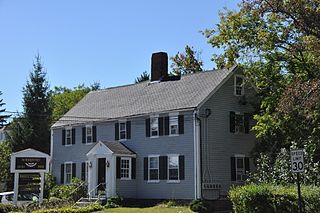
The Benjamin Coker House is a historic First Period house in Newburyport, Massachusetts. The oldest portion of the house, the central chimney and the rooms to its left, were built c. 1700 on a site at the corner of High and Federal Streets. The building was widened in the mid 18th century, adding the rooms to the right. The building was moved to its present location in 1856, and enlarged with a two-story addition on the rear. It underwent a major rehabilitation in 1989, but retains some mid 18th century decorative details.

The Emerson House is a historic late First Period house in Haverhill, Massachusetts. The oldest part of this 2+1⁄2-story wood-frame house was built c. 1730, and contains construction features characteristic of the transition between First and Second Period methods. The first part built was the central chimney with the right front rooms, which were followed later by the left side rooms, and then a rear leanto section. The left side was probably built by Nehemiah Emerson, who bought the house in 1787. The house was originally located at the corner of Winter and Pecker Streets, and was moved to its present location in the 1850s. It still retains elements of original Federal period styling.

The French–Andrews House is a historic First Period house in Topsfield, Massachusetts. The oldest elements of the house date to c. 1718, and exhibit construction techniques that are clearly derived from 17th century English methods found in other, older, First Period homes in Massachusetts. It is also notable for some surviving original decorative styling in its downstairs front rooms, and as the subject of early preservation work.

The Hart House is a historic First Period house in Lynnfield, Massachusetts. The two story, three bay wood-frame house was built in stages. The oldest portion is the front of the house, consisting of two stories of rooms on either side of a central chimney. It was probably built by John Hiram Perkins, the owner of the property from 1695 to 1719. Not long afterward, a leanto section was added to the rear, giving the house its saltbox appearance. It was acquired by John Hart in 1838, and it remained in his family until 1945. Even though the house underwent a major rehabilitation in 1968, its First Period construction is still evident.
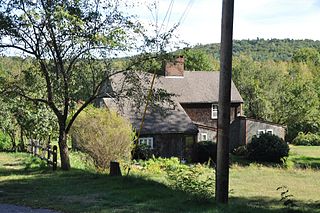
The Hastings-Morse House is a historic First Period house in Haverhill, Massachusetts. The oldest portion of the 2+1⁄2-story wood-frame house, its central chimney and right-side rooms, were probably built c. 1706 by a man named Hastings. Left-side rooms and a partial leanto section on the back of the house were added during the 18th century. The house underwent a major restoration in the late 1957, which included raising the roof on the leanto section. Another 20th-century addition is the sunroom on the left (west) side of the house. Evidence of the building's First Period origins is still visible in the right front room.

The house at 922 Dale Street is a historic First Period house in North Andover, Massachusetts. It is a 2.5-story wood-frame house, five bays wide, with a small side porch and a rear single story addition. The oldest part of the house is the right rear portion, which is estimated to have been built in the first quarter of the 18th century, along with a central chimney. Sometime between 1740 and 1780 rooms were added to its left. A major renovation during the Federal period removed the central chimney, and added rooms in front of the earlier ones, giving the main block of the house its rectangular shape. The interior has some well preserved Federal period details.

The James Noyes House is a historic First Period house at 7 Parker Street in Newbury, Massachusetts, United States. The house was built by the Reverend James Noyes, a Puritan pastor, who settled in Newbury in the mid-17th century. The Noyes family came from Wiltshire in England. The house dates from about 1646. It was added to the National Register of Historic Places in 1990.
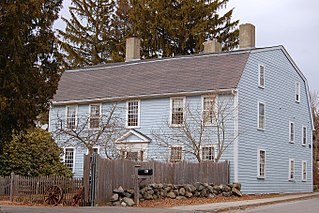
The James Putnam Jr. House is a historic First Period house in Danvers, Massachusetts. It is a 2+1⁄2-story wood-frame structure, five bays wide, with a gambrel roof pierced by three interior chimneys. The house was built in stages, beginning in about 1715 as a typical First Period double pile house, with a center entrance, chimney and winder staircase. To this another double pile structure was added to the front in the mid 1700’s creating an early Federal style central hall structure. This expansion was completed by the last Attorney General to King George III, who fled to Nova Scotia at the beginning of the Revolution. The house's most prominent Colonial resident was Colonel Timothy Pickering, who leased it from 1802 to 1804, when he was serving as United States Senator.
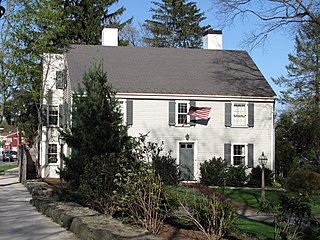
The Abraham Hill House is an historic First Period house in Belmont, Massachusetts, United States. Probably built in the early 18th century, it is one of the oldest buildings in the town. Its construction history shows changing residential trends over two hundred years of history. The house was listed on the National Register of Historic Places in 1990.

The Hopestill Bent Tavern is a historic First Period tavern in Wayland, Massachusetts, United States. The oldest portion of this 2+1⁄2-story building was built on this site c. 1710, and consisted of two rooms with a central chimney. Around 1800 a second First Period structure was moved to the site and attached to the first, giving the building most of its present form. The building is also unusual for the period in that some of its rooms have no fireplace, and that the upstairs exhibits evidence of significant reuse of older building materials, a practice that was generally restricted to the attic or basement. The building exhibits modest Federal styling, in keeping with the c. 1800 alterations.

The Joseph Damon House is a historic house in Reading, Massachusetts. Built about 1754, this 2+1⁄2-story wood-frame house is good local example of a Georgian colonial house with later Federal period alterations. It also demonstrates a typical pattern of shared ownership by multiple descendants of one of its owners. The house was listed on the National Register of Historic Places in 1984.

The Addington Gardner House is a historic First Period house in Sherborn, Massachusetts. Its oldest portions dating to about 1730, it is one of the community's oldest surviving buildings, and a good example of transitional First-Second Period style. The house was listed on the National Register of Historic Places in 1990.
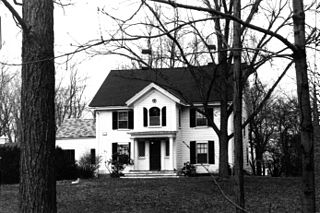
The Williams–Linscott House was a historic First Period house at 357 William Street in Stoneham, Massachusetts. The oldest part of the house was said to date to c. 1712, but it is unclear to which part of the house this referred, on account of major alterations the house in the 18th and 19th centuries. It is believed to have begun as a four-room two-story structure built around a central chimney. This underwent significant alteration during the Federal period, including replacing the center chimney with smaller side chimneys, and the construction of four more rooms in front of the original four. Sometime around 1850 Micah Williams, a prosperous farmer, again refashioned the house in the then-popular Italianate style.

The Meetinghouse is a historic house on Monument Square in Hollis, New Hampshire. Built in 1744, its oldest portion is a rare regional example of a Georgian period saltbox house. The structure was extended with a new west-facing facade sometime later, and has seen both residential and commercial use. The house was listed on the National Register of Historic Places in 1982.























